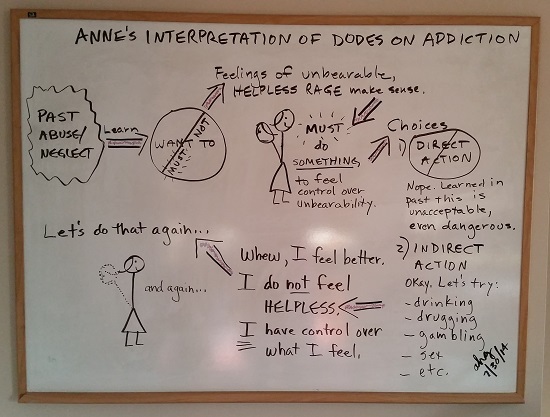I became addicted to alcohol because of helpless rage.
That’s the essence of Lance Dodes’s explanation for the origin of addictions in Breaking Addiction: A 7-Step Handbook for Ending Any Addiction (2011).
To discover if Dodes’s work could be meaningful to me, I excerpted sections important to me in story form here.
I’ve formulated his theory this way:
childhood hardship over which one feels helpless > rage at helplessness > overwhelming feeling of being trapped > aggressive feeling of need to escape > no direct action to take > an indirect, addictive action taken
And I’ve diagrammed it in the accompanying image.
(Note: Some people I work with hesitate to use the terms “neglect,” “abuse” and “trauma” to describe their pasts but are open to this generalization about their early years: “What should have happened didn’t. What shouldn’t have happened did.” In the diagram, I used “abuse” and “neglect” as shorthand.)
So let me apply Dodes’s helpless rage theory to my own story.
When I look back at my childhood – and I can’t know if they were or not – this is only my perspective, my chicken painting – I experienced my mother and father as upset with themselves, upset with how their lives were unfolding, and upset with each other. I felt born into upset. I can’t remember a time I wasn’t determinedly trying to un-upset them or to keep them from getting upset with me or with my sister. My father drove me to and from sports practices; my mother tutored me in math. I had a fine middle class upbringing. Always present, however, was just-about-to-blow upset. I wan’t conscious of it at the time but, yes, words like “trapped,” “caged,” “imprisoned” work for how I felt. I felt powerless and helpless and hopeless to transform that situation into one in which I could just relax.
Dodes asserts that the natural response to entrapment is rage. When he described the furious, direct action one would take if buried alive in a cave-in*, I could feel the rage.
“All animals react with aggression to being trapped; it’s a necessary survival instinct…This fury in addiction is actually quite normal.”
Lance Dodes, M.D., Breaking Addiction
Because what one wants to do one is forbidden to do – the direct action I wanted to take was to beg my parents to please handle their lives and just love me and not make me do all the work to calm them – Dodes believes we substitute indirect actions.
I shared in my drinking history that alcoholism didn’t start for me until in 2007. A lot happened that year for which I felt the urge to take direct action.
In 2007 when the student pushed me off balance, what I really wanted to do was push him back, possibly throw myself on him and attempt to beat and beat him. (That sounds weird and there’s more to that story but I’m observing Babette Rothschild’s caution about reliving trauma. Just writing that much makes my scalp prickle. Enough.)
I felt helpless rage over his act. Instead of responding directly, physically, I tried a lot of indirect actions to relieve my outrage. Which one would work? The glass of wine that night helped my helplessness fade. Same thing when the kid threatened to shoot me. When Cho killed my fellow Hokies and himself, I had no one to beat. I felt rage and despair and helplessness and hopelessness. Only when I had a drink did I feel like I was doing something, anything, to hold together my broken soul.
And then I couldn’t not drink.
I was 19 months abstinent from alcohol 3 days ago, on July 28. I have become aware that every time I want a drink, just before it, I have thoughts and feelings. Yes, one of those feelings could be described as “helpless rage.”
. . . . .
*When you first find yourself trapped in a tight, dark space you might try to stay calm, but that won’t last for long. Soon you’ll be banging on the rocks, clawing at them to get out. Your hands will be bloody. You might break your wrist in the desperate effort [to do something, anything to get out.] But that wouldn’t matter. At that moment the normal rage in such situations is the dominant force…It’s good to keep in mind that if you and they [people who consider addictions unusual] were trapped together in a cave-in…you would all be furiously pounding on the rocks just the same.”
– Lance Dodes, M.D., Breaking Addiction: A 7-Step Handbook for Ending Any Addiction (2011).
To see how his thinking has evolved since 2011, I’m now reading Lance Dodes’s latest book, co-written with his son, Zachary Dodes, published this year (2014), The Sober Truth: Debunking the Bad Science Behind 12-Step Programs and the Rehab Industry. I’ll share what I discover.
For further reading:
- Breaking Addiction: A 7-Step Handbook for Ending Any Addiction by Lance Dodes. Excerpts here, post here.
- The Sober Truth: Debunking the Bad Science Behind 12-Step Programs and the Rehab Industry
by Lance and Zachary Dodes. Excerpts and post here.


